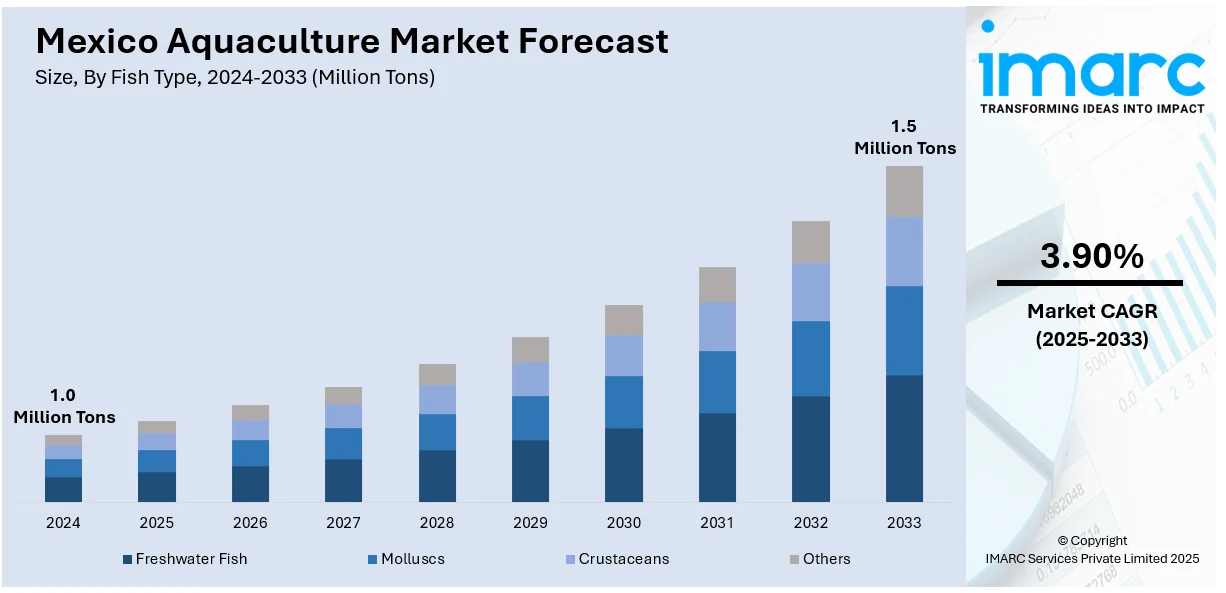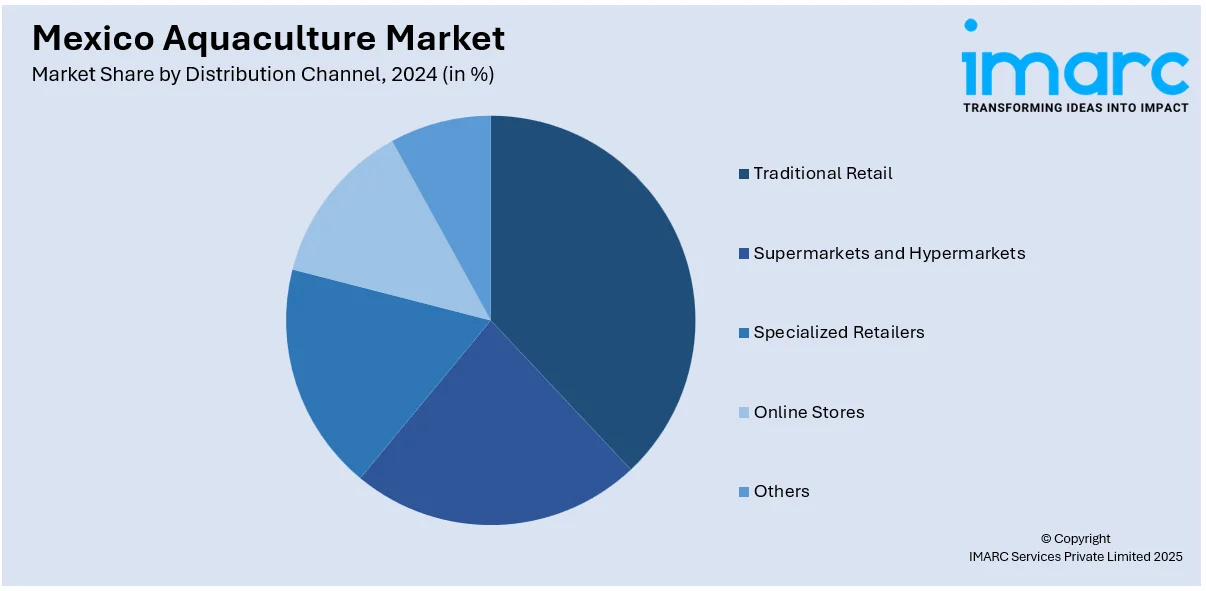
Mexico Aquaculture Market Size, Share, Trends and Forecast by Fish Type, Environment, Distribution Channel, and Region, 2025-2033
Mexico Aquaculture Market Overview:
The Mexico aquaculture market size reached 1.0 Million Tons in 2024. Looking forward, IMARC Group expects the market to reach 1.5 Million Tons by 2033, exhibiting a growth rate (CAGR) of 3.90% during 2025-2033. The market is driven by rising seafood demand, government support for sustainable fish farming, and advancements in aquaculture technology. Increasing investments in shrimp and tilapia farming, coupled with export opportunities and a focus on eco-friendly practices, are further fueling the market growth, while improved feed quality and disease management enhance overall production efficiency.
|
Report Attribute
|
Key Statistics
|
|---|---|
|
Base Year
|
2024 |
|
Forecast Years
|
2025-2033
|
|
Historical Years
|
2019-2024
|
| Market Size in 2024 | 1.0 Million Tons |
| Market Forecast in 2033 | 1.5 Million Tons |
| Market Growth Rate 2025-2033 | 3.90% |
Mexico Aquaculture Market Trends:
Expansion of Sustainable and Eco-Friendly Aquaculture Practices
The Mexican aquaculture industry is increasingly shifting towards sustainable and environmentally friendly practices. The adoption of recirculating aquaculture systems (RAS) and biofloc technology is growing, aiming to minimize water consumption and improve waste management. Certification programs like Best Aquaculture Practices (BAP) and Aquaculture Stewardship Council (ASC) are being put into practice at large to meet global standards and enhance export competitiveness. Investments in alternative sustainable feeds, such as insect-based and plant-protein sources, are further boosting the industry's sustainability credentials. Regulatory frameworks are also being beefed up to support responsible aquaculture practices. These drivers are being spurred on by increasing consumer sensitivity to environmental issues and demand for sustainably produced seafood both in domestic and export markets.

Rising Export Demand for High-Value Aquaculture Products
Mexico’s aquaculture sector continues to expand, with fisheries and aquaculture production surpassing 2 million metric tons in 2024, valued at MX$37.59 billion (approximately US$1.8 billion). High-value species like shrimp, tilapia, and tuna are fueling robust export growth, with the United States being the top destination because of growing seafood consumption and demand for responsibly produced products. The United States-Mexico-Canada Agreement (USMCA) is enabling smooth trade, increasing export revenues, and improving market access. In order to cut reliance on a single market, diversification activities are focusing on Europe and Asia. Investment in modern processing plants and cold-chain logistics guarantee high-quality products and adherence to stringent international food safety requirements. These investments are enhancing Mexico's competitiveness on the international front, making the country a primary position in the global seafood trade.
Technological Advancements Driving Production Efficiency
The integration of cutting-edge technologies is transforming Mexico's aquaculture sector, and production and efficiency are on the rise. Precision aquaculture, based on artificial intelligence (AI) and the Internet of Things (IoT), is streamlining feeding timetables, water quality monitoring, and disease outbreaks. Automated monitoring and remote sensing technologies are supporting farmers in taking informed decisions to increase yield and reduce losses. Genetic innovations in selective breeding programs are also enhancing disease resistance and growth of major aquaculture species. In addition, blockchain traceability systems are adopted to enhance the supply chain openness and respond to consumers' demand for responsibly produced seafood. These technological innovations are making the aquaculture industry in Mexico more competitive and more resilient.
Mexico Aquaculture Market Segmentation:
IMARC Group provides an analysis of the key trends in each segment of the market, along with forecasts at the region level for 2025-2033. Our report has categorized the market based on fish type, environment and distribution channel.
Fish Type Insights:
- Freshwater Fish
- Molluscs
- Crustaceans
- Others
The report has provided a detailed breakup and analysis of the market based on the fish type. This includes freshwater fish, molluscs, crustaceans, and others.
Environment Insights:
- Fresh Water
- Marine Water
- Brackish Water
A detailed breakup and analysis of the market based on the environment have also been provided in the report. This includes fresh water, marine water, and brackish water.
Distribution Channel Insights:

- Traditional Retail
- Supermarkets and Hypermarkets
- Specialized Retailers
- Online Stores
- Others
The report has provided a detailed breakup and analysis of the market based on the distribution channel. This includes traditional retail, supermarkets and hypermarkets, specialized retailers, online stores, and others.
Regional Insights:
- Northern Mexico
- Central Mexico
- Southern Mexico
- Others
The report has also provided a comprehensive analysis of all the major regional markets, which include Northern, Central, Southern Mexico, and Others.
Competitive Landscape:
The market research report has also provided a comprehensive analysis of the competitive landscape. Competitive analysis such as market structure, key player positioning, top winning strategies, competitive dashboard, and company evaluation quadrant has been covered in the report. Also, detailed profiles of all major companies have been provided.
Mexico Aquaculture Market News:
- In March 2025, Mexico launched the National Forum on The Future of Mexican Shrimp to regulate and enhance shrimp production. Led by Minister Julio Berdegué, the event gathered officials, industry leaders, and experts to discuss economic growth, environmental sustainability, and labor protection. CONAPESCA’s Alejandro Flores emphasized shrimp’s economic significance, while Undersecretary Leonel Cota highlighted the need for regulatory improvements to ensure long-term industry sustainability.
- In February 2025, Faroe Islands-based Ocean Rainforest acquired a 60% stake in Alamarsa, the Mexican company behind the Algamar brand, which produces biostimulants and seaweed-based food products. The deal expands Ocean Rainforest’s global market reach and integrates Algamar’s expertise with advanced open-ocean seaweed farming technology. The company will now produce seaweed-based products in Mexico, California, and the Faroe Islands, serving markets in the U.S., Europe, and Mexico.
Mexico Aquaculture Market Report Coverage:
| Report Features | Details |
|---|---|
| Base Year of the Analysis | 2024 |
| Historical Period | 2019-2024 |
| Forecast Period | 2025-2033 |
| Units | Million Tons |
| Scope of the Report |
Exploration of Historical Trends and Market Outlook, Industry Catalysts and Challenges, Segment-Wise Historical and Future Market Assessment:
|
| Fish Types Covered | Freshwater Fish, Molluscs, Crustaceans, Others |
| Environments Covered | Fresh Water, Marine Water, Brackish Water |
| Distribution Channels Covered | Traditional Retail, Supermarkets and Hypermarkets, Specialized Retailers, Online Stores, Others |
| Regions Covered | Northern Mexico, Central Mexico, Southern Mexico, Others |
| Customization Scope | 10% Free Customization |
| Post-Sale Analyst Support | 10-12 Weeks |
| Delivery Format | PDF and Excel through Email (We can also provide the editable version of the report in PPT/Word format on special request) |
Key Questions Answered in This Report:
- How has the Mexico aquaculture market performed so far and how will it perform in the coming years?
- What is the breakup of the Mexico aquaculture market on the basis of fish type?
- What is the breakup of the Mexico aquaculture market on the basis of environment?
- What is the breakup of the Mexico aquaculture market on the basis of distribution channel?
- What is the breakup of the Mexico aquaculture market on the basis of region?
- What are the various stages in the value chain of the Mexico aquaculture market?
- What are the key driving factors and challenges in the Mexico aquaculture market?
- What is the structure of the Mexico aquaculture market and who are the key players?
- What is the degree of competition in the Mexico aquaculture market?
Key Benefits for Stakeholders:
- IMARC’s industry report offers a comprehensive quantitative analysis of various market segments, historical and current market trends, market forecasts, and dynamics of the Mexico aquaculture market from 2019-2033.
- The research report provides the latest information on the market drivers, challenges, and opportunities in the Mexico aquaculture market.
- Porter's five forces analysis assist stakeholders in assessing the impact of new entrants, competitive rivalry, supplier power, buyer power, and the threat of substitution. It helps stakeholders to analyze the level of competition within the Mexico aquaculture industry and its attractiveness.
- Competitive landscape allows stakeholders to understand their competitive environment and provides an insight into the current positions of key players in the market.
Need more help?
- Speak to our experienced analysts for insights on the current market scenarios.
- Include additional segments and countries to customize the report as per your requirement.
- Gain an unparalleled competitive advantage in your domain by understanding how to utilize the report and positively impacting your operations and revenue.
- For further assistance, please connect with our analysts.
 Request Customization
Request Customization
 Speak to an Analyst
Speak to an Analyst
 Request Brochure
Request Brochure
 Inquire Before Buying
Inquire Before Buying




.webp)




.webp)












